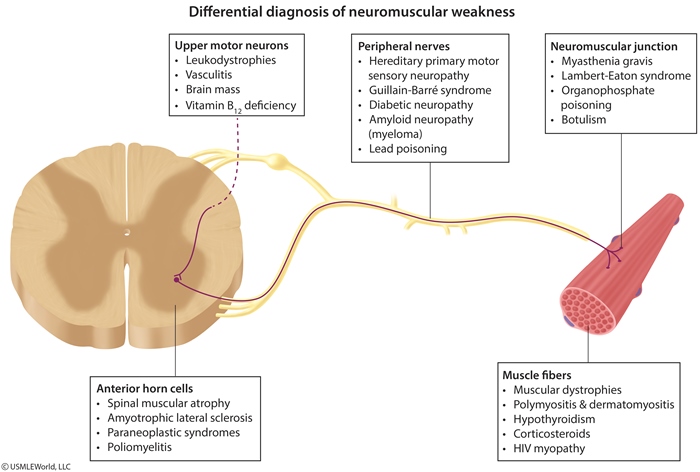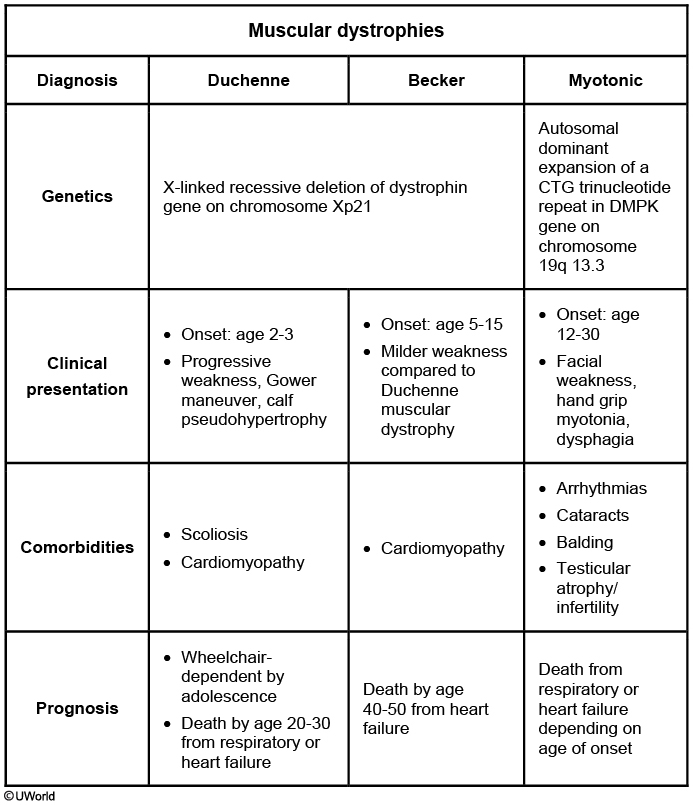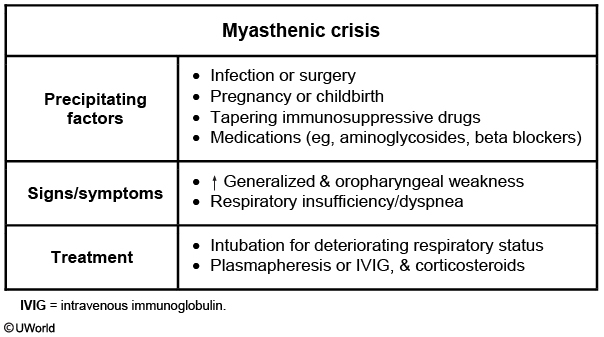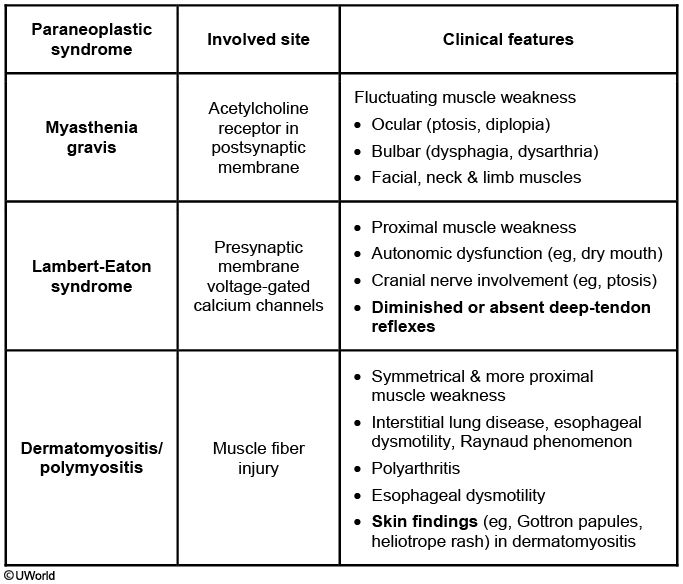Neuromuscular
Overview

DMD
Duchenne muscular dystrophy (DMD) is an X-linked disorder that is the result of a deficiency of dystrophin (subsarcolemmal cytoskeletal protein).
An overwhelming majority of the genetic defects are deletions to the dystrophin gene, causing absence of the protein.
DMD is the most common lethal muscular dystrophy.
Becker muscular dystrophy (BMD) is also an X-linked disorder that is similar in pathogenesis to DMD, but the symptoms are much less severe and the progression of symptoms occurs more slowly.
Patients with Becker muscular dystrophy have an abnormal copy of the dystrophin protein, rather than an absence.
The onset of DMD occurs between the ages of 2 and 6.
Symptoms
The weakness associated with Duchenne muscular dystrophy can present in the following ways:
Difficulty standing up and walking
Progressive clumsiness and easy fatigability
Waddling gait
Positive Gower maneuver, which is where the child will be observed pushing on their thighs with their hands in order to stand up
The weakness associated with DMD occurs in proximal muscles before distal muscles.
Pseudohypertrophy of the calf muscles due to fatty infiltration can be seen during physical examination.
Dilated cardiomyopathy may also be associated with DMD due to fibrosis of the left ventricular wall.
Myotonic Dystrophy
Myotonic dystrophy is an autosomal dominant muscular dystrophy that can present both in childhood and early adulthood.
Pathogenesis
Myotonic dystrophy is caused by trinucleotide repeats and the severity of the disease is determined by the number of repeats. While many genes are affected, skeletal muscle chloride channel dysfunction is responsible for the myotonia.
Symptoms
Myotonia is a slowed relaxation following a normal muscle contraction and is most prominent in the early stages of the illness. It is aggravated by cold and stress, and is seen most consistently in facial, jaw, tongue, and hand intrinsic muscles.
Other symptoms of myotonic dystrophy include:
Muscle weakness
Insulin resistance
Cardiac abnormalities including increased risk of cardiomyopathy, heart failure, conduction disorders, and arrhythmias
Cataracts
Testicular failure
Diagnosis
Genetic testing using PCR or southern blot assay is the test of choice for patients with suspected muscular dystrophy. While muscle biopsy used to be the initial test of choice it is now used to confirm diagnosis in patients in which genetic testing is negative or inconclusive.
Muscle biopsy findings associated with DMD include muscle fiber degeneration, fibrosis, increased fatty tissue, and basophilic fibers.
Immunostaining muscle fiber for dystrophin is diagnostic, which will show an absence of dystrophin in DMD. BMD will show some staining as there is still protein produced (albeit abnormal).
Serum creatinine kinase (CK) and aldolase levels are elevated in patients with DMD even before clinical symptoms are apparent.
Electromyography findings associated with DMD include polyphasic potentials and increased muscle fiber recruitment.
Treatment
The mainstay of treatment for patients with DMD and BMD is the use of glucocorticoids.
Management of DMD and BMD should also include:
Physical therapy
Pulmonary support
ACE-Inhibitors to decrease cardiac afterload
Complications associated with DMD include:
Progressive cardiac issues
Scoliosis
Flexion contractures
Death by age 20 as a result of respiratory issues

MG
Myasthenia gravis is an autoimmune disorder characterized by weakness of skeletal muscles resulting in easy fatigability.
Myasthenia gravis is caused by autoantibodies directed against the nicotinic acetylcholine receptors of the neuromuscular junction. The autoimmune attack on postsynaptic receptors causes muscle fatigability and weakness.
The peak incidence in women is age 20 to 30; in men 50 to 70. The disease is more common in women.
Myasthenia gravis has an association with other autoimmune diseases, such as:
Neuromyelitis optica
Autoimmune thyroid disease
Systemic lupus erythematosus
Rheumatoid arthritis
Symptoms
Worsening weakness later in the day and better with rest.
Spared reflex and sensation.
Progress slowly over years, peaking within few years of onset
Ocular symptoms: ptosis, diplopia
Bulbar: dysphagia, fatigable chewing
Skeletal: proximal limb weakness
Myasthenic crisis is a medical emergency that occurs when the diaphragm and intercostal muscles fatigue, resulting in respiratory failure. These events require mechanical ventilation.
Myasthenic crisis may be precipitated by infection, surgery, pregnancy or medications (e.g. antibiotics, cardiac drugs).

aminoglycosides, fluoroquinolones, macrolides, beta blockers
Myasthenia gravis differs from Lambert-Eaton syndrome in that Lambert-Eaton syndrome tends to present with proximal limb weakness without ocular symptoms and is associated with small cell lung cancer. Lambert-Eaton syndrome occurs due to antibodies against presynaptic calcium channels. Patients with Lambert-Eaton syndrome will also have symptoms that improve with repeated stimulation.

Myositis: reflex intact
Patients should also be evaluated and treated for a primary underlying malignancy. Symptomatic therapy includes guanidine or 3,4-diaminopyridine to increase presynaptic acetylcholine levels. Refractory symptoms may respond to immunologic therapy with intravenous immunoglobulin or oral immunosuppressants (eg, corticosteroids, azathioprine).
Diagnosis
Myasthenia gravis is diagnosed with an acetylcholine receptor antibody test (most specific).
However, as many as 20% of patients with myasthenia gravis may be antibody negative. Of these patients 38-50% will have antibodies to muscle specific receptor tyrosine kinase (MuSK). These patients may have a different cause and pathologic mechanism than AChR-Ab positive disease.
Edrophonium (Tensilon) test can be used to diagnose myasthenia gravis. Edrophonium is an acetylcholinesterase inhibitor medication that can temporarily reverse symptoms, but the test has a high false-positive rate.
The ice pack test can be used in patients with ptosis who cannot be administered the edrophonium test. This test involves putting ice packs on the eyes for two minutes and reassessing the ptosis. Ptosis should be temporarily relieved by the cold. It is based on the physiologic principle of improved neuromuscular transmission at lower muscle temperatures. At lower temperatures the acetylcholine esterase enzyme is less effective, thereby increasing acetylcholine at the synaptic junction.
EMG will reveal a decremental response to repeated stimulation of skeletal muscle.
CT scan of the chest is important to rule out thymoma, which is seen in 10-15% of patients with myasthenia gravis. Thymoma appears as an anterior mediastinal mass on imaging.
Treatment
Treatment of myasthenia gravis involves acetylcholine esterase inhibitors (e.g. pyridostigmine). These drugs will increase acetylcholine at the nicotinic receptors. These are only symptomatic treatments.
Immunosuppressive drugs, such as corticosteroids, can be used in those with poor response to acetylcholine esterase inhibitors. Azathioprine and cyclosporine are alternatives.
IV immunoglobulin therapy or plasmapheresis can be used for acute exacerbations of myasthenia gravis. If patient is in a myasthenic crisis, intubation is also necessary.
Thymectomy can provide symptomatic benefit and complete remission in many patients. It is recommended for all patients with thymoma and patients with nonthymomatous MG younger than 60 years of age.
Tay-Sachs
Tay-Sachs disease is an autosomal recessive neurodegenerative disease that is caused by excess storage of the cell membrane glycolipid GM2 ganglioside within cell lysosomes.
The GM2 gangliosidosis is caused by a deficiency of the hexosaminidase A enzyme, which is required for GM2 metabolism.
Most commonly found within the Ashkenazi Jews and French Canadian population.
Tay-Sachs presents as normal development the first few months of life, followed by progressive weakness and loss of motor skills around 2 to 6 months of age.
On examination children will have the characteristic cherry red macula and no hepatomegaly (vs. Niemann-Pick, which does).
Infants are commonly macrocephalic from accumulation of storage material in the brain.
Patients eventually develop seizures, blindness, and spasticity. The life expectancy is two to five years, with death in most cases from pneumonia.
Diagnosis of Tay-Sachs disease is made via genetic testing.
Labs of a Tay-Sachs patient will reveal decreased hexosaminidase activity.
Treatment of Tay-Sachs includes supportive care. There is no cure for Tay-Sachs disease.
Genetic screening should be offered to high risk populations to aid in the decision of having a child.
Complex Regional Pain
Complex regional pain syndrome, aka reflex sympathetic dystrophy, is neurological problem resulting from abnormal neurologic reorganization following trauma.
Following a traumatic injury, pain fibers may become reorganized (or “wired”) into sympathetic neuronal pathways, leading to chronic pain.
Symptoms
CRPS can result in both spontaneous pain and hyperalgesia.
Patients with complex regional pain syndrome will have a hypersensitive and painful limb after recovering from a traumatic injury.
Physical exam findings associated with CRPS include:
Edema
Atrophy
Abnormal tone and increased sweating at associated site
Occasional cyanosis at associated site
Occasional hair growth at injury site
Diagnosis
Imaging findings associated with CRPS include:
Decreased perfusion of the injured site via bone scan or MRI
X-ray may show osteopenia
Treatment
Suggested initial therapies for the management of CRPS include:
Physical therapy
Transcutaneous nerve stimulation (TENS)
A regional nerve block
Topical anesthetics (such as topical lidocaine)
Corticosteroids
Referral to a pain management center is frequently required in CRPS.
Refractory cases of CRPS may benefit from the use of medications that can be used for neuropathic pain, such as gabapentin and duloxetine.
Last updated
Was this helpful?